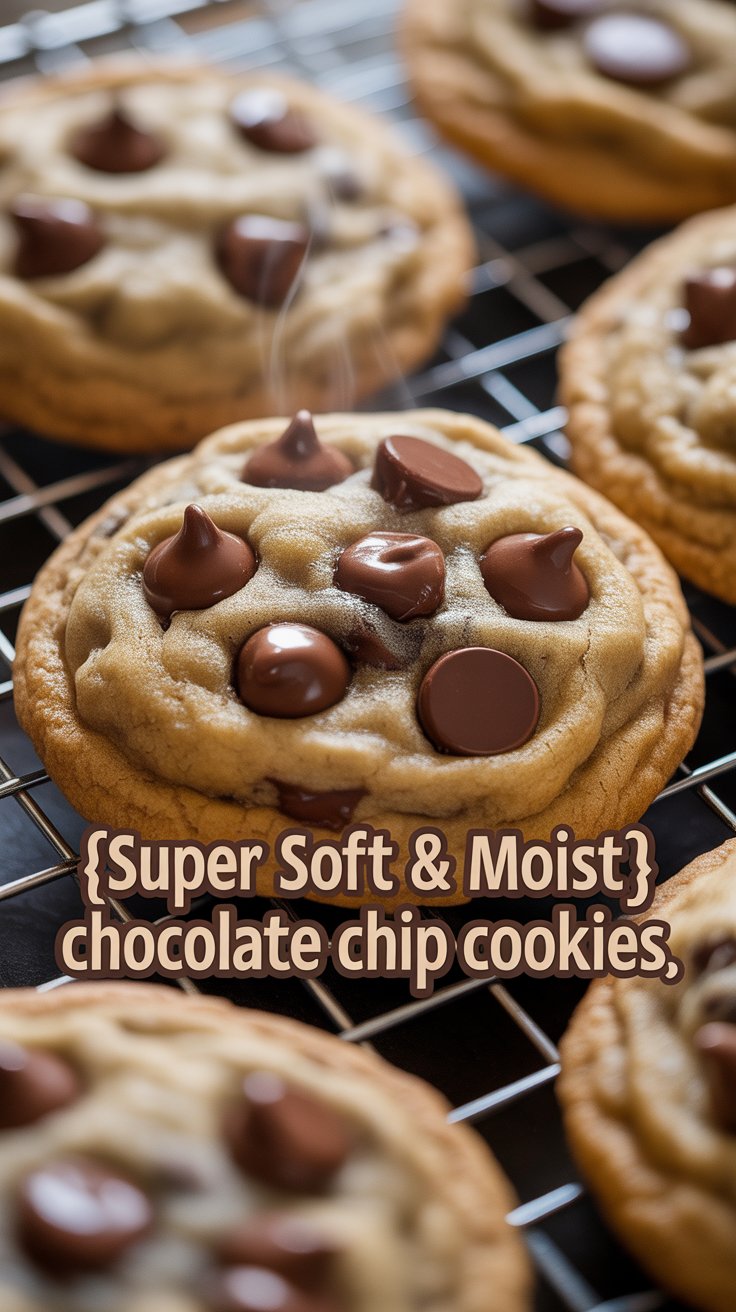
Bakery-Style Soft Chocolate Chip Cookies You Can Make at Home 2025
There are certain foods that feel like comfort in edible form, and soft chocolate chip cookies are undoubtedly one of them. The moment you break one apart and see the melted chocolate stretching from one piece to the other, you know you’re about to experience something irresistible. For decades, this cookie has been cherished in homes, bakeries, cafés, and school lunchboxes because it brings a sense of warmth, nostalgia, and simple happiness.
But here’s the truth: not all chocolate chip cookies are the same. Some are too crispy, some are too cakey, some spread too much, while others refuse to spread at all. But the perfect soft cookie—slightly crisp at the edges and wonderfully gooey in the center—is the kind of treat that makes people ask, “What’s your secret?”
This article is your ultimate guide to mastering that perfect texture. Whether you’re a beginner baker or someone who has baked thousands of cookies, you will discover techniques, variations, science, troubleshooting, and an optimized step-by-step method to create the best soft chocolate chip cookies you’ve ever made.
This isn’t just a recipe—it’s a complete baking resource, designed to help you create cookies that are soft, rich, chewy, buttery, and deeply flavorful every single time.
What Makes a Cookie Soft? (The Science of Softness)
Understanding the science behind soft cookies gives you more control and confidence in the kitchen. Softness depends on several factors:
1. Butter Temperature
Melted or almost-melted butter creates softer cookies. Solid butter introduces more air, making cookies cakey.
2. Sugar Ratio
Brown sugar contains molasses, which attracts moisture, helping cookies stay soft for days.
A higher ratio of brown sugar = softer cookies.
3. Flour Measurement
Too much flour will make cookies dry.
Too little and they will spread too thin.
A kitchen scale ensures accuracy.
4. Baking Time
Soft cookies are almost always slightly underbaked.
They finish setting as they cool, giving that gooey center.
5. Cooling Method
Cooling on the tray rather than the wire rack allows cookies to firm up slowly, preserving moisture.
6. Egg Mixing Technique
Over-beating the egg overdevelops gluten, creating cakey or tough cookies.
Once you understand these factors, you’re able to create consistently soft cookies every time.
The Origin of the Chocolate Chip Cookie (A Short Story)
Chocolate chip cookies were created by Ruth Wakefield in the 1930s at the Toll House Inn in Massachusetts. She added chopped chocolate pieces to cookie dough expecting them to melt entirely. Instead, they held their shape and created pockets of melted chocolate. This “accidental invention” became one of the most beloved desserts in the world.
Today, millions of variations exist, but the soft version remains a global favorite. Why?
Because it’s everything people want in a cookie:
✔ Chewy
✔ Flavorful
✔ Gentle on the bite
✔ Full of melty chocolate
✔ Feels fresh long after baking
Our goal in this article is to help you master this experience flawlessly.
Ingredients for Soft Chocolate Chip Cookies (And Why Each Matters)
Here is a deeper, expert-level breakdown of each ingredient:
1. Butter
Using melted butter gives your cookies a denser, chewier structure. Melted butter coats the flour more evenly and prevents the dough from becoming airy or cake-like.
2. White Sugar
White sugar helps with structure and spreading.
It also helps create a subtle crispness around the edges.
3. Brown Sugar
Brown sugar provides:
- moisture
- softness
- caramel-like depth
- better chewiness
If you want extra-soft cookies, increase the brown sugar slightly.
4. Egg
Eggs create structure and hold everything together, but overmixing leads to stiff cookies.
5. Vanilla Extract
Vanilla enhances the flavor of chocolate and butter.
Never skip it—even a small amount makes a big difference.
6. Flour
All-purpose flour keeps cookies tender and soft.
Bread flour creates chewiness.
Cake flour is too soft.
All-purpose flour is the perfect balance.
7. Baking Soda
Baking soda helps cookies spread just enough while keeping their softness.
8. Salt
A tiny amount of salt:
- balances sweetness
- enhances chocolate flavor
- gives complexity to the cookie
9. Chocolate Chips or Chocolate Chunks
Chocolate chunks melt more intensely, creating lava-like pockets.
Chocolate chips retain shape better.
A mix of both gives the perfect effect.
Step-by-Step Guide: How to Make Soft Chocolate Chip Cookies
This is a slightly enhanced and improved version of the standard process, created to maximize softness.
Step 1: Melt the Butter Perfectly
Butter should be mostly melted but not hot.
Warm butter melts sugar better and mixes smoother, ensuring soft cookies.
✔ 8 tablespoons salted butter
✔ Microwave 30–40 seconds
If the butter becomes too hot, let it cool for 3–5 minutes.
Step 2: Mix Sugars and Butter
In a mixing bowl:
- ½ cup white sugar
- ¼ cup light brown sugar
- Melted butter
Mix until smooth and glossy.
The mixture should look thick but not grainy.
Step 3: Add Egg and Vanilla
Add:
- 1 egg
- 1 teaspoon vanilla extract
Mix just until combined.
10–15 seconds is enough.
We avoid over-beating to maintain softness.
Step 4: Add Dry Ingredients
Add:
- 1½ cups all-purpose flour
- ½ teaspoon baking soda
- ¼ teaspoon salt
Mix with a spatula or spoon.
The dough should appear crumbly at first—this is normal.
Press together gently to form a smooth dough.
Step 5: Add Chocolate
Add:
✔ ¾ cup chocolate chips/chunks
✔ Press them slightly into the dough with your hands
A mix of milk, dark, and semi-sweet creates the best flavor profile.
Step 6: Shape the Dough
Roll dough into:
- 12 medium balls
or - 9 large bakery-style balls
Place evenly spaced on a cookie sheet.
Step 7: Bake
Bake at 350°F (175°C) for 9–11 minutes.
The cookies should look:
- puffy
- pale
- slightly underdone
This is exactly what we want.
Step 8: Cool on the Tray
Let the cookies sit on the baking tray for 25–30 minutes.
Why?
Because they continue setting and get denser, gooier, and softer.
Flavor Variations and Creative Customizations
Soft chocolate chip cookies are fun to customize. Here are options:
✔ Walnut or Pecan Cookies
Add ½ cup toasted nuts for crunch.
✔ Salted Chocolate Cookies
Sprinkle flaky sea salt on top before baking.
✔ White Chocolate Dream Cookies
Swap chocolate chips with white chocolate chunks.
✔ Butterscotch Cookies
Add ¼ cup butterscotch chips for buttery sweetness.
✔ Brown Butter Cookies
Toast your butter for a nuttier flavor.
✔ Nut-Free Cookies
Use seeds, dried fruit, or more chocolate.
✔ Triple Chocolate Cookies
Use dark + milk + white chocolate.
Advanced Tips for Superior Soft Cookies
Here are expert-level hacks bakers rarely share:
1. Tap the tray halfway through baking
This spreads the cookies slightly, making them denser and softer.
2. Switch to bread flour for extra chewiness
Replace ⅓ of the flour with bread flour.
3. Chill the dough for deeper flavor
Although this recipe doesn’t require chilling, resting the dough adds more depth.
4. Add cornstarch
½ teaspoon cornstarch keeps cookies thick and soft.
5. Use cold dough for thicker cookies
Warm dough spreads more; cold dough stays thick.
Troubleshooting: Why Did My Cookies…?
✔ Spread too much?
Dough was too warm.
Butter was fully melted.
Add 1–2 tablespoons more flour next time.
✔ Turn out cakey?
Egg was overmixed.
Or too much flour.
✔ Turn out dry?
Overbaked or too much flour.
✔ Not spread enough?
Add 1–2 teaspoons melted butter.
Serving Ideas
Serve soft chocolate chip cookies with:
- cold milk
- iced coffee
- vanilla or coffee ice cream
- warm chocolate drizzle
- pudding or parfait crumble
Storage Tips
✔ Room Temperature
5–6 days in an airtight container.
✔ Freezer (Baked)
Up to 3 months.
✔ Freeze Dough Balls
Bake directly from frozen, adding 1–2 minutes to the bake time.
FAQs (More Detailed, SEO-Friendly)
1. Can I use unsalted butter?
Yes—just add an extra pinch of salt.
2. Can I chill the dough?
Optional. Chilling enhances flavor but is not required.
3. Why are my cookies flat?
Butter was too hot or flour measurement was off.
4. Can I double the recipe?
Yes, it doubles perfectly.
5. Can I make it gluten-free?
Use a 1:1 gluten-free flour blend.
Final Thoughts
Soft chocolate chip cookies are more than a dessert—they’re a warm, nostalgic experience. With the right ingredients, techniques, and understanding of the science behind softness, you can create cookies that stay deliciously soft for days.
Whether you’re baking for family gatherings, school lunches, café menus, or personal enjoyment, this guide gives you everything you need to create the best soft chocolate chip cookies you’ve ever made.


